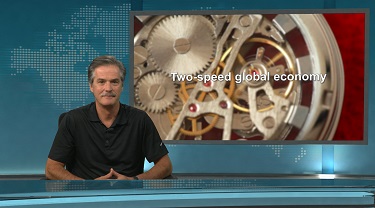In our contentious world, consensus is hard to find. But one thing that most seem to agree on is today’s two-speed economy. Central banks are saying it as often as they can. Other public officials are singing in unison, and the financial world is chiming in on the chorus. What’s the main refrain? Things at home are generally strong, and it’s the external stuff that’s weakening. In today’s integrated world, that kind of growth pattern can’t last. So, what’s the end game?
The most basic model of an economy is a circular flow. It’s one of the first diagrams economic students see. You get a job, that gives you an income, you spend a big chunk of that, which in turn empties retail shelves which then have to be replenished by making stuff. That then creates employment, and the circle continues. Add in exports and imports, government taxes and spending, saving and borrowing and there’s the system. It flows like any waterway, with most parts at roughly the same speed. Or it should. Today, the economy is more like a mechanical watch: some parts are fast, others slow, and yet others with almost imperceptible movement. Unlike a watch, economies don’t work well in that mode; slower parts aren’t welcome, and inevitably bog down the entire system.
That’s troubling, because current two-speed growth isn’t happening in some small pocket of the world economy; the giants are struggling with it. Take the U.S. for example. Second-quarter growth was 2%, slower than expected. Employment remained strong, boosting consumer spending to 4.7% growth. At the same time, export growth plummeted by 5.8%, buffeted by rising tariffs on Chinese goods and the uncertainty created by threats of further anti-trade action. Likewise, businesses are putting investments on hold.
It’s no different in Western Europe. Second-quarter growth was the slowest since early 2013, by a wide margin. Area-wide exports fell 1% and business investment in buildings plunged, while consumer spending pumped out not exactly red-hot, but reasonable 1.2% growth. Same pattern, and analysts everywhere are citing the same causes, most notably trade friction and higher tariffs.
China is not immune—far from it. As a key trading economy, China is feeling near-instant effects of the slowdown of trade in the West. Anecdotal information suggests that tariffs are affecting the trade side, and that key global businesses located in China for the express purpose of exporting to Western markets are shifting operations to Southeast Asian economies. In response, the Chinese government is loosening liquidity in order to stimulate domestic activity in yet another attempt to tide the economy through these challenging times.
The general resilience of the consumer suggests strong underlying fundamentals, at least in the West. Standard indicators agree. In the U.S., savings rates are a lot higher than in 2007, average consumer indebtedness is considerably lower, and there is no apparent let-up in the economy’s hiring binge. Moreover, as there is considerable pent-up demand for housing, there is still a lot of big-ticket spending potential. Things are similar in Western Europe. Labour constraints remain, and the aggregate unemployment rate is low. Indicators suggest substantial pent-up demand for residential and business investment. Absent the trade melee, things would be just fine.
At the same time, in spite of years of global commercial integration, trust-building at the official level, active trade-liberalizing initiatives and the extensive accompanying institutional support, business is still in general sensitive about higher-risk transactions. It may very well be ready to pull away from external activity if all is not well, retreating into the safer zone—underlining the danger of a retreat from the general post-war de-risking of the external economy.
The bottom line?
To many, this looks like an inexorable move toward protectionism and isolation. Not so; it is still very fixable. Despite the apparent difficulties, the North American deal was agreed. The U.S. and China keep coming back to the table. Why? Because the cost of impasse is so great. Turn it around, and we are back to balanced growth.
This commentary is presented for informational purposes only. It’s not intended to be a comprehensive or detailed statement on any subject and no representations or warranties, express or implied, are made as to its accuracy, timeliness or completeness. Nothing in this commentary is intended to provide financial, legal, accounting or tax advice nor should it be relied upon. EDC nor the author is liable whatsoever for any loss or damage caused by, or resulting from, any use of or any inaccuracies, errors or omissions in the information provided.





